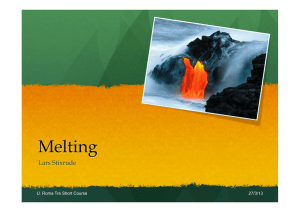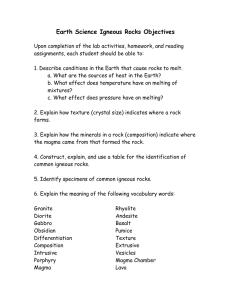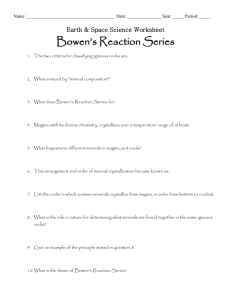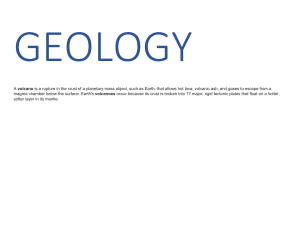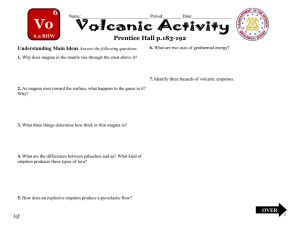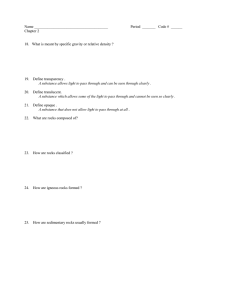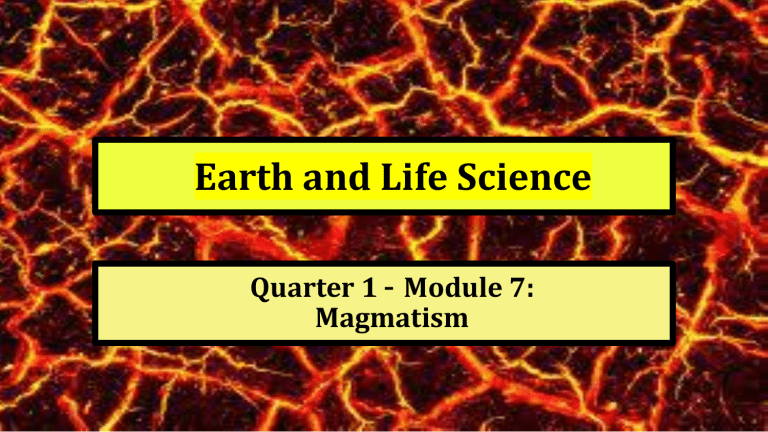
Earth and Life Science Quarter 1 – Module 7: Magmatism After going through this module, you are expected to: 1. describe the characteristics of magma; 2. identify the substances/elements present in magma; and 3. explain the processes involved in the formation of magma. Magmatism Do you still remember what happened to Taal Volcano last January 12, 2020? Yes, you are right. This volcano, which is located at the province of Batangas, spewed ash plumes up to nine miles (14 kilometers) into the air due to a “steam-driven” or phreatic eruption. According to the Philippine Institute of Volcanology and Seismology (PHIVOLCS), for the past two days, over 600 volcanic tremors have been recorded which was an indication of continuous movement of magma or molten rocks beneath the volcano. You might be wondering how magma got inside the volcano. For this module, we will be discussing all about magma, its formation and composition. Activity 1. Decoding Time In the previous lesson, you have learned that Earth’s interior is the site of great amount of heat. Let us review first about this before proceeding to the next topic. Your task is to reveal the magic words by decoding the given numbers to their corresponding letters of the alphabet. Then, complete the statement below using those words. 5 E 1 A 18 R Example: Word: EARTH 20 T 8 H 18 1 1. Word: 4 9 1 10 9 15 14 18 1 4 9 15 7 5 14 9 3 2. Word: 8 5 1 20 3 15 3. Word: 14 4 21 3 20 9 15 14 3 15 4. Word: 14 22 5 3 20 9 15 14 Picture Analysis Observe the picture of Mount Mayon and answer the following. Mount Mayon is one of the most active volcanoes in the Philippines. It erupted for eight minutes last January 23, 2018, spewing a 3-mile-tall column of debris and volcanic gas. It exploded at least five more times for two days. According to Philippine Institute of Volcanology and Seismology (PHIVOLCS), two “explosion-type earthquakes” had occurred, as well as 18 tremor events — some of which sent forth fountains of lava. One of the lava flows advanced nearly 2 miles from the summit’s crater. What is Magma? Magma is composed of semi-liquid hot molten rocks located beneath the Earth, specifically in the melted mantle rock and oceanic plate. This molten state, when solidified, creates igneous rocks found on the surface of the Earth. Do you know the difference between magma and lava? Magma and lava are both molten rocks. However, they differ in location. Magma is found in the magma chamber of the volcano while lava is found on the surface of earth once the volcano erupts. Magmatism is a process under the earth’s crust where formation and movement of magma occur. So where does these formation and movement take place? These happen in the lower part of the Earth’s crust and in the upper portion of the mantle, known as asthenosphere. Figure 1. Convection Process in Asthenosphere On the given figure, identify the substances/elements present in magma. How is magma formed? The magma present in the lower crust and upper mantle of the Earth is formed or generated through the process of partial melting. In this process, different minerals in rock melt at different temperature and pressure. Another factor being considered in this process is the addition of volatile materials such as water and carbon dioxide. This is a diagram showing how minerals in rocks undergo partial melting. This solid rock contains the minerals quartz, feldspar, biotite, and hornblende. The first minerals that melt are quartz and some types of feldspar. The background represents magma. Minerals such as biotite and hornblende generally melt last, which changes the composition of magma. Figure 3. The Process of Partial Melting Melting in the mantle requires one of three possible events to occur: 1. An increase in temperature: Conduction in mantle happens when heat is transferred from hotter molten rocks to the Earth’s cold crust. This process is known as heat transfer. As magma rises, it is often hot enough to melt the rock it touches. It happens at convergent boundaries, where tectonic plates are crashing together. Figure 4. Heat Transfer in Convergent Boundary Rocks are composed of minerals. These rocks start to melt once the temperature in the lower crust and upper mantle increases or exceeds the melting point of minerals. The temperature of mantle is around 1200 degrees Celsius. Rock minerals such as quartz and feldspar begin to partially melt at around 650-850 degrees Celsius. 2. A decrease of pressure: Mantle rocks remain solid when exposed to high pressure. However, during convection, these rocks tend to go upward (shallower level) and the pressure is reduced. This triggers the melting of magma. This is known as decompression melting. This process occurs at the Mid-Ocean Ridge, an underwater mountain system. Figure 5. Depression Melting in Mid-Ocean Ridge 3. Addition of volatiles: When water or carbon dioxide is added to hot rocks, flux melting occurs. The melting points of minerals within the rocks decrease. If a rock is already close to its melting point, the effect of adding these volatiles can be enough to trigger partial melting. It occurs around subduction zones. Figure 6. Flux Melting in Subduction Zone THANK YOU! 감사합니다 Gamsahabnida!

